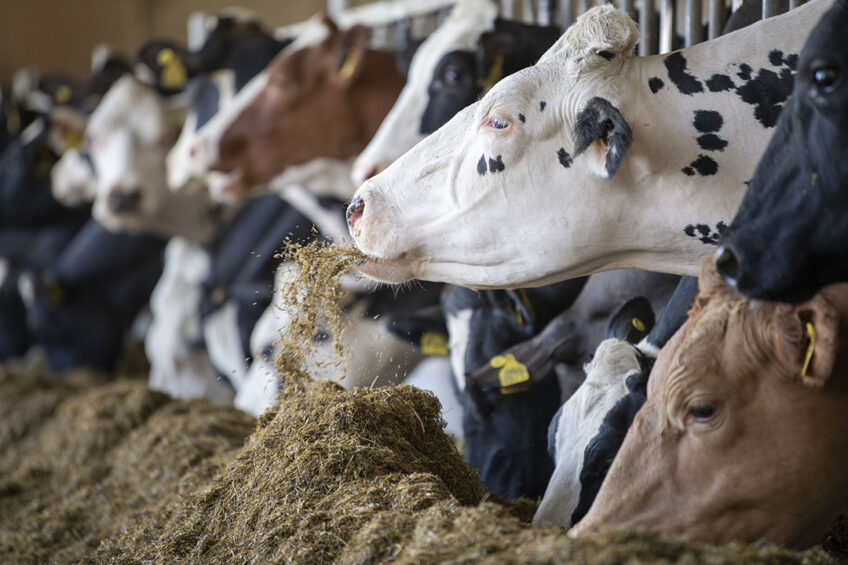Feed efficiency: Multi-cut silage, diet changes, genomics

A multi-cut silage system, changes in diet and the use of genomics are boosting feed efficiency for third-generation farmer Andrew Gilman.
At Statfold Farm in Staffordshire in the UK, Gilman runs a year-round calving herd of 300 Holstein and Swedish Red and Pro Cross cows, averaging 10,000 litres per cow year at 3.9% fat and 3.3% protein on the 450 acres of grass and maize, including 70 acres of permanent pasture. Cows are mostly housed during the year, although youngstock graze and cows are let out during their dry period.
Sexed semen is used for replacements, with the rest for beef. Breeding decisions are data-driven using milk quality and serve per conception as the current main drivers. Cows are milked 3 times a day through a 20/20 herringbone parlour. Gilman supplies Arla on a liquid milk contract aligned with Asda.
Cow fertility and reduced lameness
Over the next 3 years, Gilman aims to improve cow fertility and reduce lameness while focusing on nutrient management and better utilising slurry.
Gilman is currently using a multi-cut silage system to help with feed efficiency. At an Agriculture and Horticulture Development Board open day, he said: “I decided to go down the multi-cut route because I wanted a more consistent quality of the grass silage that is produced on the farm. Multi-cutting has helped us to do that. We see a similar analysis of every cut of silage that we make as opposed to before when we just did 2 cuts – we’d have first cut, really good quality, and a significantly poorer quality second cut which would then have implications on cow yields when it came to feeding it.”
More energy, more protein
David Levick of Kite Consulting said it was a no-brainer: “When you look at the overall efficiency of those fields producing the grass, we’re getting between 35-45% more energy and more protein than we are from a conventional 3-cut system, so we’re growing our own energy and protein which allows us to cut back – in Andy’s case – of 3kg of concentrate per day in the cow’s ration, which is a massive saving and allows us to focus on protein efficiency, getting the diet protein down to 16%.”
Levick said work at Wageningen University in the Netherlands shows clearly that this is the most efficient way of producing milk.
Replacing soya and palm in cow diets
Gilman has also replaced soya and palm from the cow’s diet. The soya has been replaced by ordinary rape seed meal with little change in performance and production. Palm fat (C16) has also been taken out, which had been in for some time as it gave a good return on investment, but feedback from processors was that they didn’t like it as it was causing issues with cleaning machinery. It was also coming from the other end of the planet with a higher carbon footprint, and quite a lot of it is undigested. So, palm fat was replaced by some methionine analogue, which controls the digestive system and stops milk fat depression at a third of the cost. It also boosts milk protein.
Gilman has been using genomic testing for a number of years: “What attracted me, in the beginning, was that it took breeding decisions away from the subjective and gave you a scientific, reliable measurement of the quality of your next generation of heifers. Over the past 3 years, there has been a bigger focus on feed efficiency to produce a more efficient animal to produce increased levels of milk for less feed.”
Progression of the last few years through genomics has allowed Gilman to make specific choices around real data rather than predicted PTAs. There have been rapid changes from when he started genomic testing; every single aspect has seen big improvements. The overall rate of gain in Gilman’s herd is improving 50% faster than the national herd.
Levick said efficiency meant looking at the whole farm. Profitability gives you an idea of efficiency, but every part of the farm needs to be working well, which includes high-performing healthy cows but also motivated staff, staff that want to stay on the farm, a resilient business that can cope with ups to downs of milk prices and not just the feed side.
Levick said the introduction of a new shed was helping the production of milk with lots of thoughts and ideas: “There are no skylights in the shed, so no heat stress in the summer and controlled lighting to make the cow happier and more comfortable.”
Join 13,000+ subscribers
Subscribe to our newsletter to stay updated about all the need-to-know content in the dairy sector, two times a week.










